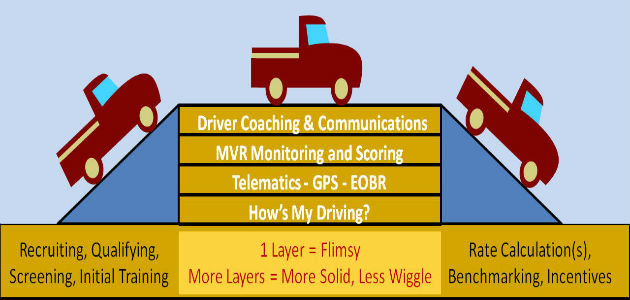CLICK TO READ: HOW TO CREATE AN IN-HOUSE FLEET SAFETY PROGRAM. PART ONE
Communication:
Communication related to the program, as well as the safety policy is also crucial — it can make the difference between a successful initiative and one that languishes.
Drivers, as has been previously noted, know how to drive. But, when distracted by the pressures of doing the job, driving safely can often take a back seat to getting to a customer on time.
Communicating the safety message regularly keeps it at the forefront. It is the repetition of the safety message — rather than training drivers to do, or not do, what they already know — that ensures success. Safety should be a part of any meetings — in person or via webinar conference call — drivers have. A safety newsletter can be provided weekly or monthly to all. Safe driving can be prominently featured on the company intranet. With the electronic tools fleet managers have today, getting the message out — and repeating it — is not difficult.
Telematics:
Finally, telematics should play a part in a safety program despite being a relatively new technology related to driver safety. Among the various data telematics can provide are “events,” such as rapid acceleration, idling, speeding, harsh braking, and more. Tracking these events can reinforce the after-the-fact results seen on an MVR, for example. They can provide invaluable warning signs related to unsafe driving that enable fleet managers to be proactive in keeping drivers safe.
Preparing the outlined program for introduction and implementation takes time (if done right), but is worthwhile in keeping drivers safe, avoiding corporate liability, and reducing costs.
IMPLEMENT THE PROGRAM
The program has been outlined, approvals have been obtained, and the specifics of the content and delivery are now in place. The final step will be introduction and implementation.
Again, electronic communication gives fleet managers today tools that weren’t even on the radar screen as recently as 20 years ago. Up until then, the only ways fleet managers had to communicate the message were via fax, telephone, and actual hard copy.
A formal announcement of the program can be made through several venues, including the corporate intranet site, a fleet website (if there is one), e-mail, and/or social media.
The announcement, to be most effective, should be led by the approval and endorsement communication obtained from the C-level executive. Keep it upbeat and positive; note that the company and fleet management are most concerned with keeping drivers safe, and, in light of this concern, are introducing the fleet safety program. Lay out the details in each of the programs’ elements, how the programs will be implemented and tracked, and what the drivers’ and their managers’ responsibilities will be.
Any fleet management company will tell you that, as much or more than anything else, a well-structured and smooth implementation will help ensure the success of any program. After announcing the program, the implementation begins.
Subsequent to the initial announcement of the program, the form and content of the ongoing communication must be developed. One page is usually sufficient. Content can include a safety-related maintenance tip (e.g., how to measure remaining tread on a tire), a defensive driving tip, and even perhaps a quiz (which doesn’t necessarily have to do with safety). Don’t forget the recognition of any award-winning drivers. And, consider social media for further communication, including Facebook and Twitter.
In addition, make sure to choose a telematics provider, and arrange for installation of any hardware. Work with that provider to develop reporting of events, and a process for distributing reports to the field.
Regarding the actual training of drivers, determine what form the training should take, and how and where it will be provided. For truck fleets, behind-the-wheel training is important — proper backing and use of mirrors, judging length and height when parking, and other truck-related issues. Push for any field meetings to include safety training; this can be accomplished via webcast, online, or even through a written test. For drivers who have high MVR point totals, additional formal training should be mandatory. The focus should be on defensive driving techniques and accident avoidance.
Developing, obtaining approval for, and implementing an in-house fleet safety program should be a natural progression once a fleet safety policy has been put in place. It can be a challenging project, but the rewards can be substantial, both in cost savings and in the comfort of knowing that drivers, passengers, cargoes and the public will be safer for it.
Source: Automotive-fleet.com







